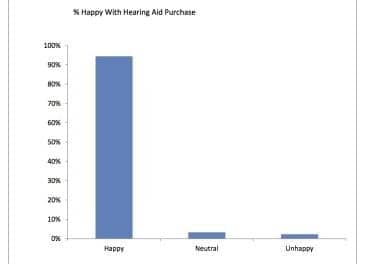Focusing on keeping current clientele can unlock hidden growth for hearing care practices.
By Michele Ahlman
For many hearing care professionals, the focus has traditionally been on attracting new patients and successfully guiding them through the care process. Lead generation and new patient acquisition dominate conversations around business growth. But what if the key to long-term success isn’t in chasing new leads but rather in nurturing the patients you already have?
The obsession with lead generation has led many clinics to operate as sales-driven organizations rather than patient-centered service providers. While new sales may be a necessary metric, an imbalanced focus on acquisition creates a blind spot—one that puts clinics at significant risk.
The Revenue Engine: Your Current Patients
The reality is that your power and profit lie in the patients already in your database. Your existing patient base is the engine that keeps your clinic running, and when nurtured correctly, it ensures consistent growth, higher revenue, and a thriving practice.
Too often, clinics measure success solely by the number of new patients acquired. But what happens if you’re losing as many patients as you gain? This turnover, or “leakage,” is a bigger threat to long-term sustainability than a slow month of lead generation. If your practice loses more patients than it brings in, you are on a path to decline.
A Case Study in Misdiagnosed Problems
Consider the story of a successful clinic struggling with declining revenue. When asked about the problem, the owner quickly blamed poor lead generation. Direct mail was no longer yielding results, and third-party referrals were dominating the schedule. However, a closer look at the numbers revealed a different story.
While the clinic was fixated on bringing in new patients, their revenue from returning patients had dropped by 20% from the previous year. In reality, their biggest problem wasn’t new patient acquisition—it was patient retention. The very engine of their business had slowed down, yet all their focus remained on chasing leads for new patients rather than retaining existing ones.
The Cost of Churn vs. The Value of Retention
One of the most overlooked and undervalued aspects of a clinic’s business is the service visit. When new sales are prioritized over ongoing patient relationships, service visits and follow-ups get pushed down the priority list. This short-term thinking causes long-term damage.
Every hearing aid patient represents an ongoing opportunity. If nurtured properly, they will return for upgrades, maintenance, and referrals. On the other hand, failing to re-engage existing patients means they are likely to take their business elsewhere when the time comes for a new set of hearing aids.
Metrics That Matter
Rather than focusing only on new patient numbers, clinics should make use of their practice management software/system to track key performance metrics that provide a clearer understanding of patient retention and business health. By leveraging the capabilities of their software, clinics can generate reports, analyze trends, and make data-driven decisions that enhance patient engagement and improve long-term profitability.
Clinics should track:
- The number of current patients with scheduled follow-ups.
- The percentage of patients returning for their next hearing aid purchase.
- Revenue from existing patients versus new patient sales.
- The number of inactive patients who have not been seen in the past two years.
These metrics provide a clearer picture of business health than lead generation alone. Leakage of existing patients is a more significant indicator of trouble than a drop in new leads.
Creating a Culture of Patient Retention
To transition from a sales-driven organization to a partnership-based practice, consider implementing the following strategies:
- Onboarding Patients Into a Nurturing System
- Ensure every patient has an appointment scheduled at all times.
- Follow up with personalized check-ins and reminders.
- Implement a structured post-fitting engagement plan.
- Enhancing the Value Proposition
- Define the specific value your clinic offers beyond hearing aids.
- Segment patients based on their needs (e.g., price-conscious vs. service-oriented) and tailor your approach accordingly.
- Emphasize ongoing care, not just a one-time transaction.
- Mastering the Schedule
- Allocate appointment slots for different patient needs, ensuring a balance between new patient consultations and service visits.
- Train staff to prioritize follow-ups and maintain consistent patient communication.
- Measuring Success Beyond Lead Generation
- Track the percentage of patients returning for their next hearing aid purchase.
- Assess appointment scheduling efficiency and follow-through rates.
- Monitor revenue distribution between new and existing patients.
Creating a Nurturing System
A well-structured nurturing system ensures patients remain engaged with your clinic long after their initial hearing aid purchase. Consider a scenario where you have 500 active customers—patients who have purchased hearing aids directly from you and have visited within the past 12 months. If your nurturing system ensures that each patient replaces their hearing aids every five years, your practice will remain stable and profitable without additional lead generation costs.
Many clinics underestimate the importance of clean-and-check appointments. While these visits may not generate immediate revenue, they are the foundation for long-term patient retention. Some practitioners worry that filling their schedules with service visits will limit time for new patient consultations. However, consider these two fundamental truths:
- If you do not maintain communication and bring your existing customers back into the clinic, they are unlikely to return for their next hearing aid purchase.
- If you do nurture your patients through consistent engagement, they will return for their next hearing system from you.
A clean-and-check appointment requires only 20-30 minutes of your time—an investment that is significantly lower than the cost of acquiring a new patient through marketing. Compare that to the cost of lead generation, which can range from $400 to $1,000 per new patient. The return on investment is clear: prioritizing ongoing patient engagement yields higher long-term revenue than focusing exclusively on new acquisitions.
Key Elements of a Patient Nurturing System
Regular Communication
Engage with patients through personalized emails, phone calls, and social media updates. Utilize automated email campaigns to provide educational content about hearing health, reminders for follow-up visits, and exclusive promotions. Implement SMS messaging to send appointment confirmations and quick check-ins. Conduct targeted social media campaigns that highlight patient success stories, provide hearing care tips, and encourage engagement through interactive content such as polls and Q&A sessions. By integrating these various communication channels, clinics can create a seamless and effective engagement strategy that fosters long-term patient loyalty.
Consistent Scheduling
Ensure every patient has an appointment booked at all times. Implement automated scheduling reminders through your practice management system to notify patients when they are due for follow-up visits. Train front desk staff to always schedule the next appointment before a patient leaves the clinic. Offer convenient online booking options so patients can easily schedule their own visits. Consider implementing a recall program to proactively reach out to patients who haven’t been seen in a while. By ensuring every patient remains scheduled for ongoing care, you strengthen retention, improve patient outcomes, and create a steady revenue stream for your practice.
Waiting Room Engagement
Utilize in-clinic touchpoints to reinforce your commitment to patient care. This includes leveraging digital signage such as CDM TV to stream engaging video content that tells your clinic’s story, educates patients about hearing health, and underscores the importance of treating hearing loss. By using these digital tools, you create an immersive experience that keeps patients informed, strengthens trust, and encourages them to take proactive steps in their hearing journey.
Appointment Reminders
Automated and personal reminders help maintain patient commitment. Clinics can implement text message reminders to confirm upcoming appointments, reducing no-show rates. Personalized email reminders can be sent with educational content about hearing health and instructions for appointment preparation. Automated phone calls can reinforce appointment details for patients who may prefer verbal communication. Additionally, using patient portals or mobile apps can allow patients to manage their appointments, receive reminders, and reschedule as needed, creating a seamless experience that fosters engagement and accountability.
Mastering Your Schedule
Allocate time strategically to balance new consultations with existing patient care. Effective scheduling is critical to balancing patient care and business success. Clinics that implement structured scheduling systems optimize their time while improving patient retention. Some practices use schedule blocking, where specific time slots are allocated for different types of appointments, such as opportunity appointments, clean-and-checks, fittings, and annual re-checks. Others implement color-coded scheduling, where different appointment types are visually distinguished—e.g., green for opportunity appointments, gold for service visits, blue for fittings, and red for troubleshooting. It is essential to own the schedule rather than letting patients dictate it. This ensures a balanced workload and prevents inefficiencies.
By implementing these strategies, your clinic can foster deeper patient relationships, reduce patient leakage, and create a sustainable, thriving practice.
The Path Forward
The reality is simple: Without an active, engaged, and retained patient base, no amount of new patient acquisition can sustain long-term growth. A clinic that loses as many patients as it gains will remain stagnant or decline.
By shifting the focus from aggressive lead generation to patient retention and engagement, hearing care clinics can unlock a more stable and profitable future. Power and profit are not in the pursuit of new patients alone—they are in the relationships you’ve already built.
The question now is: What are you doing to keep your patients coming back?
Michele Ahlman is CEO and founder of Clear Digital Media, an Austin,Texas-based small business that has developed a digital content management and signage platform that streams professionally created, educational video content into the waiting rooms of hearing healthcare practices throughout the United States and Canada. She also serves as president and founder of ClearSounds Communications, a manufacturer of assistive listening devices, and founder of Citadel Digital Signage Software.
Featured image: ID 151076389 © Robert Kneschke | Dreamstime.com





